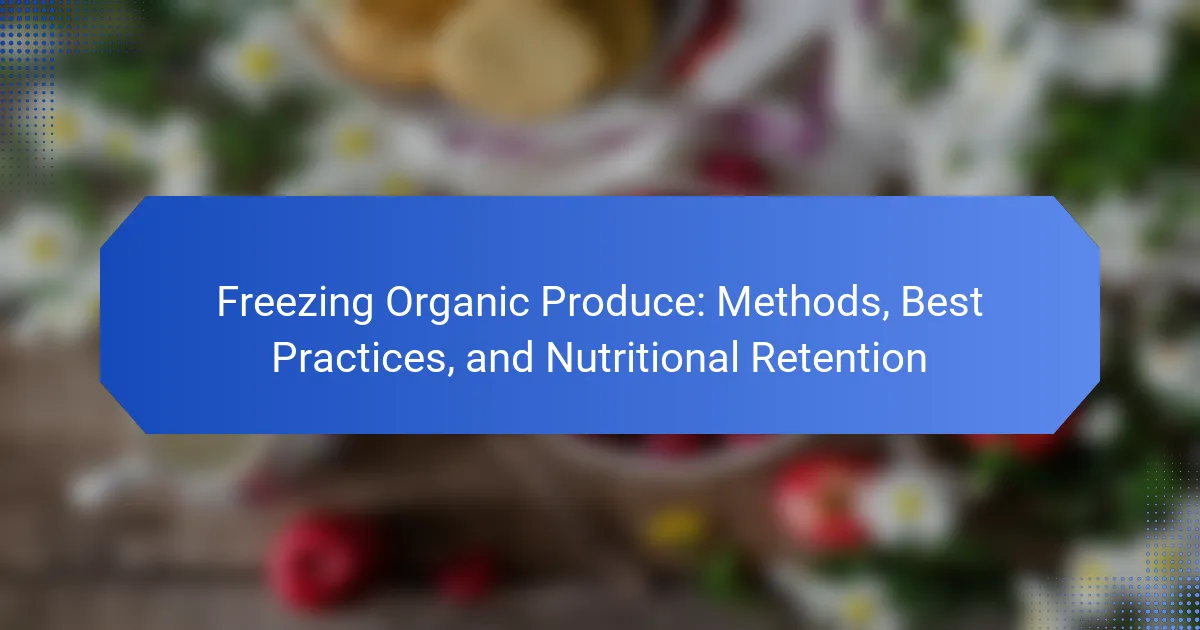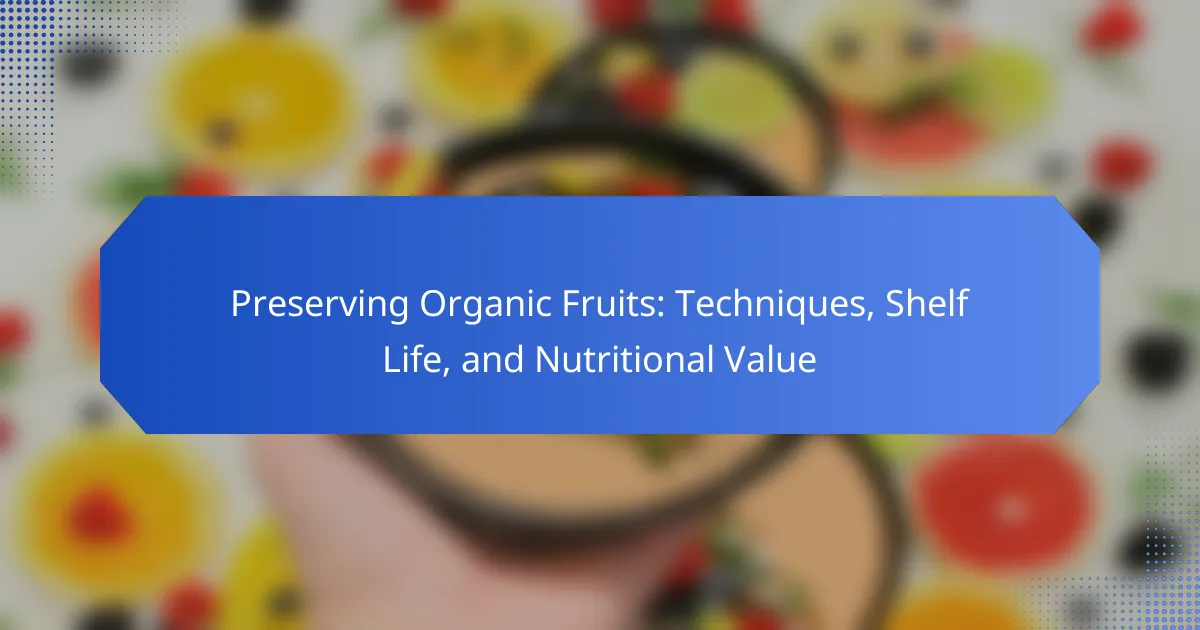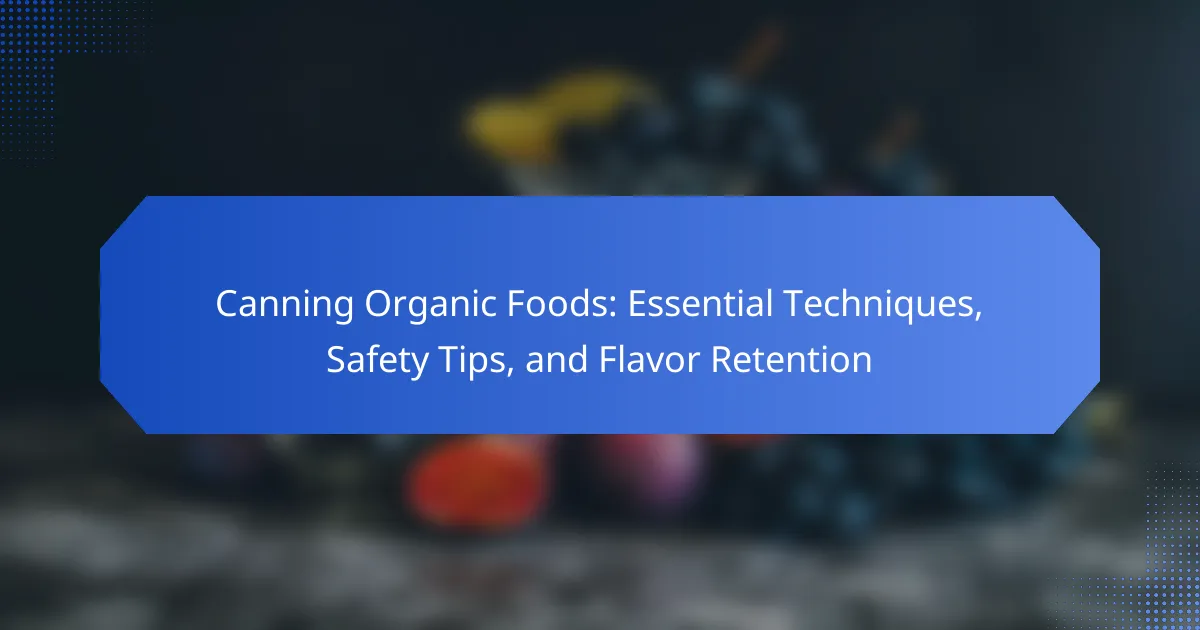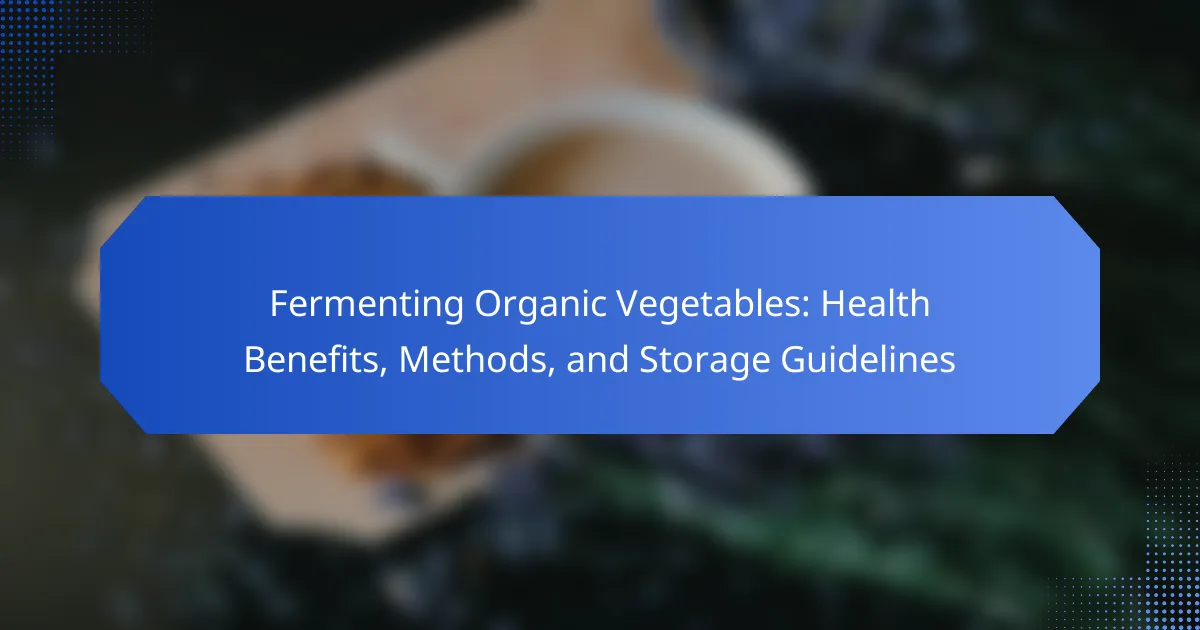Dehydrating organic foods involves the removal of moisture from fruits, vegetables, and herbs, effectively preserving them while enhancing their flavors and nutrients. This method prevents the growth of bacteria, yeasts, and molds, allowing for long-term storage without the need for refrigeration. Common dehydration techniques include air drying, sun drying, oven drying, and using food dehydrators, each retaining essential vitamins and minerals. Proper storage in airtight containers is crucial for maintaining freshness, with ideal conditions extending the shelf life of dehydrated foods from six months to several years. The article provides detailed insights into these techniques, their benefits, and best practices for storage.
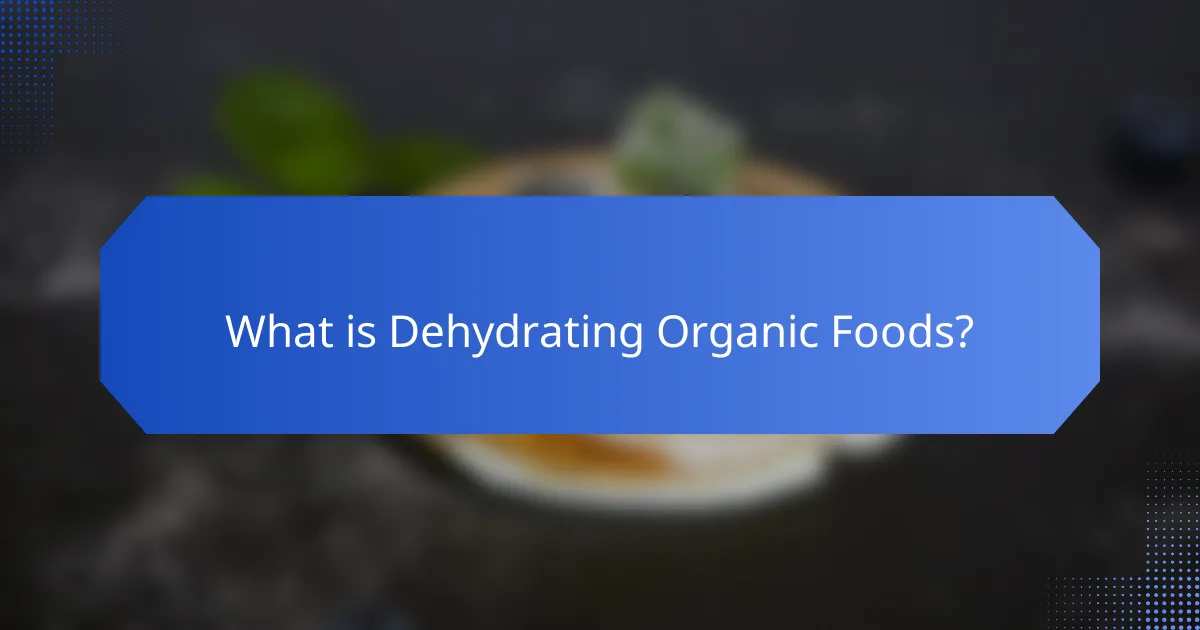
What is Dehydrating Organic Foods?
Dehydrating organic foods is the process of removing moisture from fruits, vegetables, and herbs. This technique preserves the food while concentrating its flavors and nutrients. Dehydration inhibits the growth of bacteria, yeasts, and molds. It allows for long-term storage without refrigeration. Common methods include air drying, sun drying, and using dehydrators or ovens. Research shows that dehydrated foods retain most of their vitamins and minerals. This preservation method is efficient for minimizing food waste and maintaining a healthy diet.
How does the process of dehydrating organic foods work?
Dehydrating organic foods removes moisture to preserve them. The process involves several steps. First, the organic food is washed and sliced to ensure even drying. Next, the food is placed in a dehydrator or an oven at a low temperature. Heat is applied to evaporate the water content. This process usually takes several hours, depending on the type and thickness of the food. Once dried, the food should be stored in airtight containers to maintain its quality. Dehydration can extend shelf life by reducing microbial growth and spoilage.
What methods are commonly used for dehydrating organic foods?
Common methods for dehydrating organic foods include air drying, sun drying, and using dehydrators. Air drying involves placing food in a well-ventilated area to remove moisture naturally. Sun drying utilizes sunlight to evaporate moisture, ideal for warm climates. Dehydrators are electric appliances designed to circulate warm air for efficient moisture removal. Each method varies in efficiency and speed. Studies show that dehydrators often retain more nutrients compared to other methods.
What equipment is needed for dehydrating organic foods?
Dehydrating organic foods requires a food dehydrator, which is the primary equipment. A food dehydrator circulates warm air, effectively removing moisture from the food. Some people may also use an oven set to a low temperature as an alternative. Additionally, airtight containers are necessary for storing the dehydrated foods. A cutting board and sharp knife are essential for preparing the food. Lastly, a digital scale can help in measuring the food portions accurately. Each piece of equipment plays a crucial role in the dehydration process, ensuring the food retains its flavor and nutrients.
What are the advantages of dehydrating organic foods?
Dehydrating organic foods offers several advantages. It extends shelf life by removing moisture, which inhibits microbial growth. This preservation method maintains nutritional content effectively. Dehydrated foods are lightweight and easy to store. They also retain flavors, making them ideal for snacks and meals. Additionally, dehydration reduces food waste by allowing surplus produce to be preserved. Studies show that dehydrated fruits and vegetables can retain up to 90% of their nutrients. Overall, dehydrating organic foods is a practical and efficient way to enjoy healthy options year-round.
How does dehydrating organic foods preserve nutrients?
Dehydrating organic foods preserves nutrients by removing moisture while retaining vitamins and minerals. This process minimizes enzymatic activity that can lead to nutrient loss. Dehydration slows down the deterioration of food, maintaining its nutritional profile. Studies show that dehydrated foods can retain up to 90% of their original nutrients. For example, dried fruits often have higher fiber and antioxidant levels compared to their fresh counterparts. Additionally, the absence of water inhibits the growth of microorganisms, further protecting nutrient content. Overall, dehydration is an effective method for extending the shelf life of organic foods while keeping their nutritional value intact.
What cost benefits can be realized from dehydrating organic foods?
Dehydrating organic foods can significantly reduce costs related to food waste and storage. By removing moisture, the shelf life of organic foods extends, minimizing spoilage. This process allows consumers to purchase organic produce in bulk, often at discounted rates.
Dehydrated foods require less storage space compared to fresh items, leading to lower storage costs. Additionally, the reduced weight of dehydrated foods can lower shipping costs.
According to a study by the USDA, dehydrated fruits and vegetables retain most nutrients while providing convenience and cost savings. This method also enables consumers to enjoy seasonal organic produce year-round, further enhancing cost efficiency.
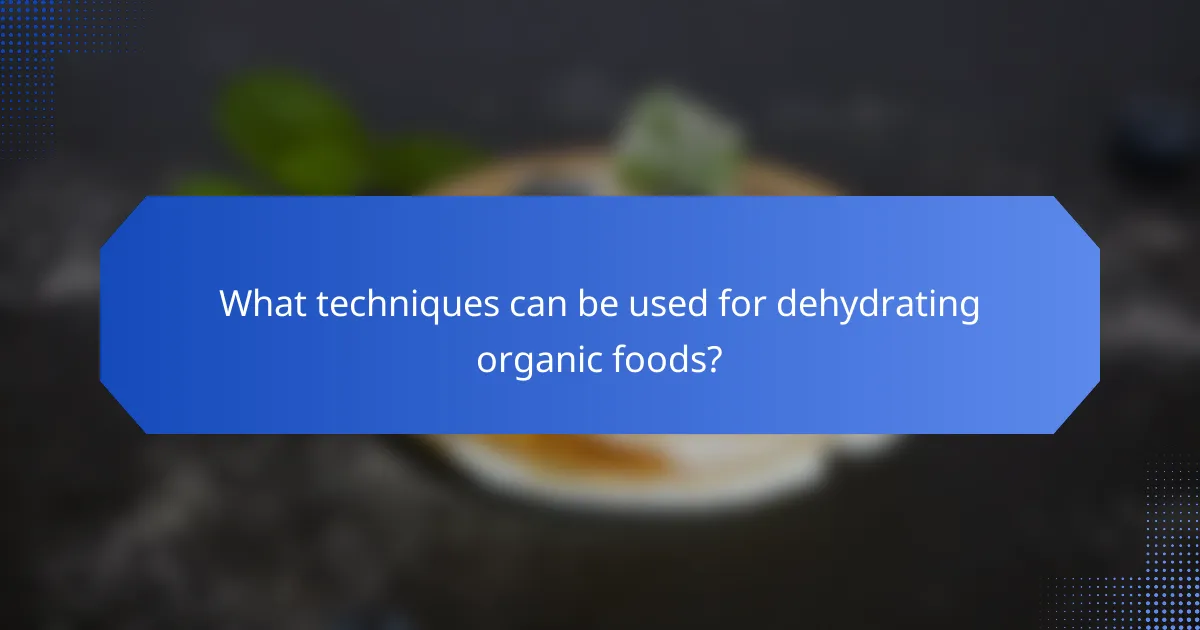
What techniques can be used for dehydrating organic foods?
Techniques for dehydrating organic foods include air drying, sun drying, oven drying, and using a food dehydrator. Air drying involves hanging food in a well-ventilated area. This method is effective for herbs and small fruits. Sun drying requires direct sunlight and low humidity. It is suitable for fruits like tomatoes and apricots. Oven drying uses low heat settings to remove moisture. This technique works well for vegetables and meats. A food dehydrator is a specialized appliance that circulates warm air. It allows for controlled drying and is efficient for various foods. Each method retains nutrients and flavors while extending shelf life.
How can one effectively dehydrate fruits and vegetables?
To effectively dehydrate fruits and vegetables, one should use methods like air drying, oven drying, or using a food dehydrator. Air drying involves placing food in a warm, dry area with good airflow. Oven drying requires setting the oven to a low temperature, usually around 140°F (60°C). A food dehydrator provides a controlled environment for consistent drying.
Preparation is crucial. Wash and slice the fruits or vegetables evenly to ensure uniform drying. Blanching vegetables before drying helps preserve color and nutrients. The drying process removes moisture, which inhibits mold and bacteria growth.
For optimal results, monitor the drying time. Fruits generally take 6 to 12 hours, while vegetables may take 4 to 10 hours, depending on thickness and moisture content. Properly dehydrated food should be leathery and pliable, not sticky or moist.
Storing dehydrated fruits and vegetables in airtight containers in a cool, dark place extends shelf life. Properly dried and stored, these foods can last for months or even years.
What are the best practices for preparing fruits for dehydration?
The best practices for preparing fruits for dehydration include selecting ripe fruits, washing them thoroughly, and cutting them into uniform sizes. Ripe fruits ensure optimal flavor and texture after dehydration. Washing removes dirt and pesticides, ensuring food safety. Cutting fruits into uniform sizes promotes even drying.
Additionally, blanching some fruits, like peaches or apples, can preserve color and flavor. Soaking fruits in a solution of lemon juice and water can prevent browning. Finally, drying fruits promptly after preparation minimizes spoilage and maintains quality. Following these practices enhances the overall dehydration process and final product quality.
How should vegetables be processed before dehydration?
Vegetables should be washed, peeled, and cut into uniform pieces before dehydration. Washing removes dirt and pesticides from the surface. Peeling may be necessary for certain vegetables to enhance texture and taste. Cutting vegetables into uniform sizes ensures even drying. Blanching is recommended for some vegetables to preserve color and nutrients. This process involves briefly boiling vegetables and then cooling them in ice water. Blanching also helps in reducing enzyme activity, which can affect flavor and color. After processing, vegetables should be thoroughly dried before storing to prevent spoilage.
What role does temperature play in dehydrating organic foods?
Temperature is crucial in dehydrating organic foods as it directly affects moisture removal. Higher temperatures accelerate water evaporation, speeding up the drying process. However, excessive heat can damage nutrients and alter flavors. Optimal temperatures for dehydration typically range from 125°F to 135°F. This range preserves the integrity of vitamins while efficiently removing moisture. Studies show that maintaining appropriate temperatures can enhance the quality of dried foods. For example, research indicates that drying fruits at lower temperatures retains more antioxidants. Thus, temperature management is essential for effective and nutritious dehydration.
What temperature settings are optimal for different types of foods?
Optimal temperature settings for dehydrating different types of foods vary. Vegetables typically dehydrate best at 125°F to 135°F. Fruits require slightly higher temperatures, around 135°F to 145°F. Herbs should be dried at lower temperatures, between 95°F and 115°F. Meat jerky is most effective when dehydrated at 160°F. These temperature ranges ensure proper moisture removal while preserving flavor and nutrients. Accurate temperature settings are crucial for food safety and quality during the dehydration process.
How does humidity affect the dehydration process?
Humidity significantly impacts the dehydration process by influencing the rate at which moisture is removed from organic foods. High humidity levels slow down dehydration because the surrounding air is already saturated with moisture. This saturation creates a barrier that limits evaporation from the food surface. Conversely, low humidity levels enhance dehydration by allowing moisture to escape more freely into the air. In environments with low humidity, the air can absorb more water vapor, facilitating faster drying. Studies show that optimal dehydration occurs in conditions with humidity levels below 60%. Therefore, controlling humidity is critical for effective dehydration in organic food preservation.
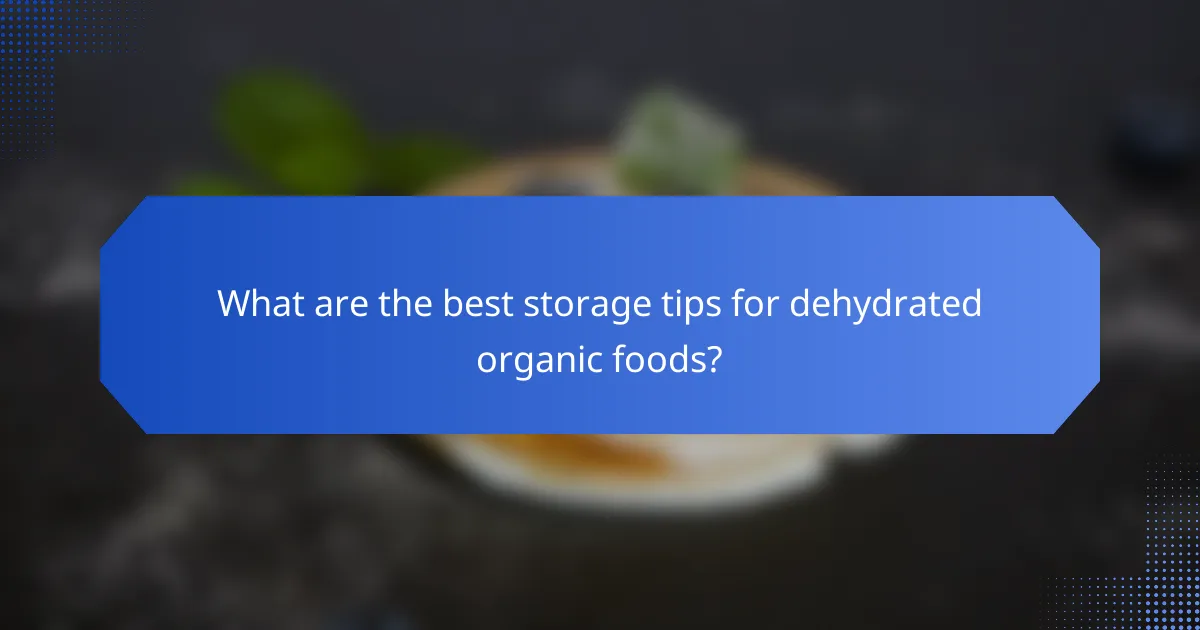
What are the best storage tips for dehydrated organic foods?
Store dehydrated organic foods in airtight containers to maintain freshness. Glass jars, vacuum-sealed bags, or mylar bags with oxygen absorbers work well. Keep these containers in a cool, dark, and dry place to prevent moisture and light exposure. Ideal storage temperatures are between 50°F and 70°F. Label containers with the date of dehydration for tracking freshness. Regularly check for signs of spoilage, like off odors or discoloration. Properly stored, dehydrated foods can last from six months to several years, depending on the food type.
How should dehydrated foods be stored for maximum shelf life?
Dehydrated foods should be stored in airtight containers to maximize shelf life. This prevents moisture absorption, which can lead to spoilage. Glass jars, vacuum-sealed bags, or mylar bags with oxygen absorbers are ideal for storage. Keep the containers in a cool, dark place away from direct sunlight. A consistent temperature below 60°F (15°C) is best for long-term storage. Properly stored dehydrated foods can last from 1 to 5 years, depending on the type of food. For example, fruits may last up to a year, while vegetables can last several years. Regularly check for any signs of spoilage or moisture.
What containers are ideal for storing dehydrated foods?
Airtight containers are ideal for storing dehydrated foods. These containers prevent moisture and air from entering, which can cause spoilage. Glass jars with tight-fitting lids are a great option. They are non-reactive and do not absorb odors. Mylar bags with oxygen absorbers are also effective. They provide a barrier against light and air. Vacuum-sealed bags can extend shelf life significantly. They remove air and minimize oxidation. Food-grade plastic containers are another choice, but ensure they are BPA-free. Properly labeled containers help track storage times.
How can one prevent moisture from affecting stored dehydrated foods?
To prevent moisture from affecting stored dehydrated foods, use airtight containers. Airtight containers limit air exposure and humidity. Mylar bags with oxygen absorbers are effective for long-term storage. Vacuum sealing also removes air and moisture. Store dehydrated foods in a cool, dark place. High temperatures can degrade food quality. Additionally, use desiccants like silica gel packets to absorb excess moisture. Regularly check stored foods for signs of moisture or spoilage. These methods ensure the longevity of dehydrated foods.
What are common mistakes to avoid when dehydrating and storing organic foods?
Common mistakes to avoid when dehydrating and storing organic foods include not properly washing and preparing the food. This can lead to contaminants remaining on the surface. Failing to cut the food into uniform pieces can result in uneven drying. Overloading the dehydrator can hinder airflow, affecting the drying process. Not monitoring the drying time can cause foods to be under-dried or over-dried. Storing dehydrated foods in non-airtight containers can lead to moisture absorption. Lastly, neglecting to label containers can result in confusion about the contents and expiration dates. These practices can significantly impact the quality and safety of dehydrated organic foods.
What signs indicate that dehydrated foods have gone bad?
Dehydrated foods have gone bad if they show signs of moisture, off odors, or visible mold. Moisture can cause clumping or a sticky texture. Off odors indicate spoilage or rancidity. Mold appears as dark spots or fuzzy growth. Discoloration can also signal that the food is no longer safe. Additionally, an unusual taste may indicate deterioration. These signs are crucial for ensuring food safety.
How can one troubleshoot issues encountered during the dehydration process?
To troubleshoot issues encountered during the dehydration process, first identify common problems such as uneven drying, moisture retention, or food spoilage. Uneven drying can occur due to improper airflow. Ensure that food items are arranged in a single layer and not overcrowded in the dehydrator. Moisture retention may happen if food is not dried long enough. Check the recommended drying times for specific foods and adjust accordingly. Food spoilage can result from inadequate temperature settings. Maintain the dehydrator at the appropriate temperature, usually between 125°F to 165°F, depending on the food type. Additionally, regularly inspect the dehydrator for cleanliness and functionality. This ensures efficient operation and prevents contamination.
Dehydrating organic foods is the process of removing moisture from fruits, vegetables, and herbs to preserve them while concentrating their flavors and nutrients. This article covers various methods of dehydration, including air drying, sun drying, and using dehydrators, along with the necessary equipment for effective dehydration. It highlights the advantages of this preservation technique, such as extending shelf life, reducing food waste, and maintaining nutritional content. Additionally, best practices for preparing, storing, and troubleshooting dehydrated foods are discussed to ensure optimal quality and safety.
